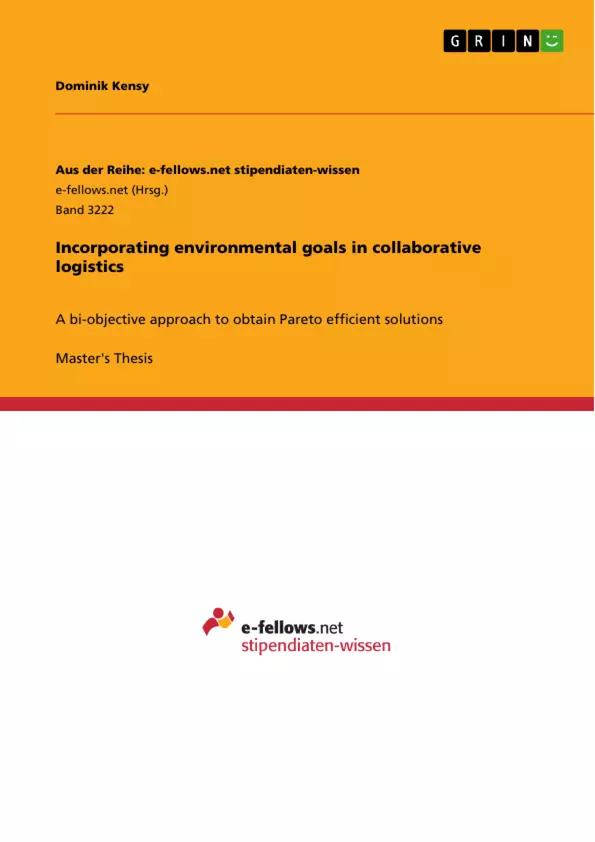The increasing interest in sustainability and the growing number of directives and legislations pressure companies to investigate means to reduce their carbon footprint.
This thesis considers horizontal collaboration between logistics companies who jointly plan their distribution routes. Horizontal agreements can lead to significant economic and environmental benefits if the participating companies are able to combine complementary activities. Methodologies are presented to deal with the operation of horizontal collaboration in logistics based on multi-objective optimisation and cooperative game theory. Extensive work has been dedicated to the software implementation of collaborative vehicle routing heuristics using the Pareto efficiency principle to find candidate solutions. The heuristics were tested with benchmark instances from literature to illustrate how the methodologies apply. The solutions to these test instances give a hint on the potential savings in CO2e-emissions in the collaborative setting. In one solution, the companies are able to save between 11.9% and 24.7% CO2e-emissions simultaneously, compared to their standalone scenarios. However, the results also indicate that, based on the allocated costs, players may favour different cost allocation methods. In this case, the companies need to find consensus on a cost allocation method for example based on the properties of the different methods presented in this thesis. A special focus is laid on the different methods to allocate the total cost (CO2e-emissions) onto the members of the coalition.
Inhaltsverzeichnis (Table of Contents)
- Abstract.
- Acknowledgements
- Introduction....
- Literature review……………………..
- Greenhouse gas-emissions and the environment......
- The greenhouse effect.
- EU-legislations on GHG-emissions.
- Calculating CO2-emissions........
- A Green Vehicle Routing Problem
- A green multi-depot vehicle routing problem with time windows.......
- Constructive heuristic
- Cooperative Game Theory..
- The core..
- Cost allocation methods
- Shapley value....……………….
- Nucleolus.
- Equal Profit Method
- Volume-based allocation.
- Star method..
- Weighted Star method.
- Cost allocation methods
- The core..
- Multi-objective horizontal collaboration in logistics........
- Horizontal collaboration
- Multi-objective optimisation........
- "Traditional” solution methods..
- Scalarization
- E-Constraint Method.
- The coalition efficiency approach.
- Step 1: Aggregation..
- Step 2: Optimisation at the coalition level
- Metaheuristic solution approach..
- Step 3: Projection on individual partner objective
- Step 4: Evaluation..........\li>
- The partner efficiency approach.
- Objective functions...
- Solution evaluation
- Computational experiments.
- Benchmark instances.
- Simulation results
- Standalone solutions
- Coalition efficiency approach.
- Partner efficiency approach.
- Simulation with three partners.
- Properties of cost allocation methods.
- Concluding remarks and outlook
- Bibliography..
Zielsetzung und Themenschwerpunkte (Objectives and Key Themes)
This thesis investigates the potential of horizontal collaboration between logistics companies to reduce their carbon footprint. It explores how multi-objective optimization and cooperative game theory can be used to design efficient and environmentally-friendly distribution routes. The study focuses on finding Pareto efficient solutions that optimize both economic and environmental objectives.- Horizontal collaboration in logistics
- Multi-objective optimization for route planning
- Cooperative game theory for cost allocation
- Green vehicle routing problem (GVRP)
- Reducing CO2 emissions in logistics
Zusammenfassung der Kapitel (Chapter Summaries)
- Introduction: This chapter introduces the thesis topic, outlining the increasing need for sustainability in logistics and the potential of horizontal collaboration to reduce CO2 emissions. It provides an overview of the research problem, objectives, and the structure of the thesis.
- Literature review: This chapter reviews relevant literature on green vehicle routing problems, multi-objective optimization, and cooperative game theory. It explores existing research on horizontal collaboration in logistics and the use of Pareto efficiency for finding optimal solutions.
- Greenhouse gas-emissions and the environment: This chapter provides background information on greenhouse gas emissions and their impact on climate change. It discusses relevant EU legislations and methodologies for calculating CO2 emissions in logistics.
- A Green Vehicle Routing Problem: This chapter introduces a green multi-depot vehicle routing problem with time windows (MDVRP-TW) as the specific problem addressed in the thesis. It discusses the model formulation, incorporating both economic and environmental objectives. A constructive heuristic is presented for generating feasible solutions for this problem.
- Cooperative Game Theory: This chapter discusses the use of cooperative game theory for cost allocation in collaborative logistics. It introduces key concepts such as the core, Shapley value, nucleolus, and various allocation methods. It explores the advantages and disadvantages of each method for distributing the total cost of collaboration.
- Multi-objective horizontal collaboration in logistics: This chapter explores the application of multi-objective optimization techniques for achieving Pareto efficient solutions in collaborative logistics. It introduces the concept of horizontal collaboration, discussing the benefits and challenges. Different solution methods are presented, including scalarization, E-Constraint Method, and the coalition efficiency approach. The chapter focuses on the metaheuristic solution approach for finding non-dominated solutions.
- Computational experiments: This chapter describes the computational experiments conducted to evaluate the performance of the proposed methodologies. It introduces benchmark instances used for testing and presents the simulation results. The results include both standalone solutions and collaborative solutions using different cost allocation methods. The chapter analyzes the CO2 emissions reduction achieved through collaboration and discusses the properties of different cost allocation methods.
Schlüsselwörter (Keywords)
The core of the thesis revolves around the intersection of sustainability, logistics, multi-objective optimization, cooperative game theory, and the Green Vehicle Routing Problem. The research focuses on exploring the benefits of horizontal collaboration in logistics, implementing Pareto efficient solutions, and devising effective cost allocation methods within a collaborative setting. The thesis seeks to demonstrate the potential for CO2 emissions reduction in logistics through strategic partnerships and optimized route planning.- Arbeit zitieren
- Dominik Kensy (Autor:in), 2019, Incorporating environmental goals in collaborative logistics, München, GRIN Verlag, https://www.grin.com/document/496874



